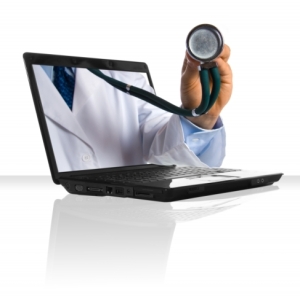According to a January 2008 study titled How America Searches, Health and Wellness:
 In the past 12 months, 59% of adults reference the internet to find or access health and wellness information.
In the past 12 months, 59% of adults reference the internet to find or access health and wellness information.- 67% of adult searchers use general search engines as an online tool or resource for health information and only 7% referred to online drug advertisements.
- 36% of adult searchers use online health information to see what other consumers say about a medication or treatment
Because of statistics like those above, the concept of ‘Health 2.0’ has increased its usage and importance. Simply, Health 2.0 = the merging of social media into healthcare. However, others see the movement of Health 2.0 as something much wider and farther reaching. Even Google image searching shows a variety of more complex definitions. I’d be interested to see how you all define it for yourselves or for your practice.
Examples of Health 2.0
Websites
- Carol.com , started in 2006, is the marketplace for care, allowing hospitals and providers to ‘bid’ for consumers’ care
- Vitals.com, allows patients to review their current doctor’s or a potential doctor’s reviews and ratings
- DoubleCheckMD, allows consumers to check for potential drug interactions quickly and easily
- American Well , creates a healthcare marketplace where consumers and physicians come together online to acquire and provide convenient and immediate healthcare services
Wikis
- Wikipedia
- FluWiki
- WiserWiki, a medical and healthcare information wiki edited exclusively by physicians
- Clinfo Wiki, a wiki devoted to clinical informatics
- Ask Dr. Wiki, allows those with a medical background to publish review articles, clinical notes, pearls and/or medical images to the wiki. The main focus has been on Cardiology and Electrophysiology, but they have expanded to other areas.
Blogs
- DiabetesMine, a blog all about diabetes
- HealthMatters (Healthline), a collection of weblogs by professionals, covering different aspects of health, wellness, treatments, and recent advances
- WebMD, provides health and health-related information
Social Networks
- OrganizedWisdom, the first human-powered search service for health information
- PatientsLikeMe, find patients who are receiving the same or similar treatments
- DailyStrength, helps one find support groups
- Sermo, a community for physicians to share information, questions and observations amongst themselves, encouraging collaboration
- ReliefinSite, helps with pain managemnt
- NursesRecommendDoctors
- TheHealthCareScoop
Video-Sharing
- ICYou, the source of healthcare videos and videos related to health information
- Cleveland Clinic on Google Video
- TauMed, a virtual health community where one can search and share information on a variety of health topics
Online Forums
- Revolution Health Groups
- Google Health Groups, find support and community groups
- iVillage
Podcasts
- Johns Hopkins Medical Podcasts
- NIH Podcasts
- NY Times Health Pocasts
- CDC Travelers Health
- dLife podcasts for diabetes, information and inspiration for those with diabetes
Caution
Health 2.0 researchers warn that patients should be cautious about posting personal health-related information through unsecured social media as health insurance providers could gain access to this information, as well as potential employers.
Future
Social Media combined with health information, patients and user-generated content can be used for:
- User-generated health ratings for hospitals and doctors
- Bridge the gap between doctor and patient
- Bring communities together in new, innovative ways
- Establishing patients as opinion leaders
- Managing health and managing community health in new ways
For specific case studies and more information, view this report titled: The Wisdom of Patients: Health Care Meets Online Social Media prepared for the California Healthcare Foundation by Jane Sarasohn-Kahn.
Questions to Ponder
- Is Health 2.0 helpful or harmful?
- Is the content trustrworthy? Does it matter? Will consumers take the information at face value?
- Why are patients labeled as consumers? What does this mean/say about how health 2.0 is being approached?
- What are the ethical concerns?
- What are the privacy concerns?
Can’t wait to read your insights in the comments. =)

